Family

 Many little girls dream of becoming a princess. They may not dream of it for long, before reality sets in, but at some point, most little girls want to be a princess, even if it is just Cinderella. For one actress, Grace Kelly, that dream came true on April 18, 1956, when she married Prince Rainier III of Monaco. The couple met the year before at the Cannes Film Festival, went on to have three children…Caroline, born January 23, 1957; Albert II, born March 14, 1958; and Stephanie, born February 1, 1965.
Many little girls dream of becoming a princess. They may not dream of it for long, before reality sets in, but at some point, most little girls want to be a princess, even if it is just Cinderella. For one actress, Grace Kelly, that dream came true on April 18, 1956, when she married Prince Rainier III of Monaco. The couple met the year before at the Cannes Film Festival, went on to have three children…Caroline, born January 23, 1957; Albert II, born March 14, 1958; and Stephanie, born February 1, 1965.
Grace Kelly, the daughter of a former model and a wealthy industrialist, was born on November 12, 1929, in Philadelphia. Her talent was obvious early on, and she began acting as a child. Then, after high school, she attended the American Academy for Dramatic Arts in New York. She had found her niche…or so she thought.  After her schooling, she began to audition for Broadway plays. She was a classic blonde beauty, who supported herself by modeling and appearing in TV commercials, while awaiting her “big break.”
After her schooling, she began to audition for Broadway plays. She was a classic blonde beauty, who supported herself by modeling and appearing in TV commercials, while awaiting her “big break.”
In 1949, Kelly debuted on Broadway in a play called “The Father” by August Strindberg. She was on her way. Then two years later, she landed her first Hollywood part. Granted, it was a bit part, in a movie called “Fourteen Hours,” but it was a part. Her big break came in 1952, when she starred as Gary Cooper’s wife in the Western “High Noon.” Her performance in 1954’s “The Country Girl,” as the wife of an alcoholic actor and singer played by Bing Crosby, won her a Best Actress Oscar (Kelly beat out Judy Garland in “A Star is Born”). Among Kelly’s other acting credits were three Alfred Hitchcock thrillers: “Dial M for Murder” (1954), with Ray Milland and Robert Cummings, Rear Window (1954), with James Stewart, and “To Catch a Thief,” with Cary Grant. Her last big-screen role was in 1956’s “High Society,” a musical adaptation of 1940’s The Philadelphia Story, co-starring Bing Crosby and Frank Sinatra. By this time, Grace Kelly was on her way to retirement from the movies, because she was about to become a “real-life” princess. That little girl dream was going to come true for her…and for a number of years, Grace Kelly lived that dream.
Then, on September 14, 1982, her dream came to an end. Princess Grace of Monaco…the American-born 
 former film star Grace Kelly, whose movie credits include The Country Girl and Rear Window, and who was known as the darling of the United States, and the dream of many little girls, died at the age of 52 from injuries suffered after her car plunged off a mountain road near Monte Carlo. Princess Grace was driving with her youngest daughter, Stephanie, when she reportedly suffered a stroke and lost control of her car, which plunged down a mountainside. Seventeen-year-old Stephanie survived, but Princess Grace died the following day. Her death was mourned by millions of fans around the world.
former film star Grace Kelly, whose movie credits include The Country Girl and Rear Window, and who was known as the darling of the United States, and the dream of many little girls, died at the age of 52 from injuries suffered after her car plunged off a mountain road near Monte Carlo. Princess Grace was driving with her youngest daughter, Stephanie, when she reportedly suffered a stroke and lost control of her car, which plunged down a mountainside. Seventeen-year-old Stephanie survived, but Princess Grace died the following day. Her death was mourned by millions of fans around the world.

 Every kid gets excited about their birthday and being another year older. Most start saying they are their age and a half pretty early on, but for my grandniece, Mackenzie Moore, the excitement maybe went to the extreme. In fact, she’s been talking about turning seven since she turned six!! Hahaha!! So, to think the day has finally arrived is…well, the best birthday gift ever!! Oh, don’t get me wrong, I’m sure she is excited about birthday gifts and such, but being seven is just the coolest most important part of her birthday.
Every kid gets excited about their birthday and being another year older. Most start saying they are their age and a half pretty early on, but for my grandniece, Mackenzie Moore, the excitement maybe went to the extreme. In fact, she’s been talking about turning seven since she turned six!! Hahaha!! So, to think the day has finally arrived is…well, the best birthday gift ever!! Oh, don’t get me wrong, I’m sure she is excited about birthday gifts and such, but being seven is just the coolest most important part of her birthday.
Mackenzie is kind, and she has such a sweetheart. Like her mom, Lindsay Moore, Mackenzie is a social butterfly…she is a friend to everyone she meets. Mackenzie is truly a such a delightful person. She is easy going and fun. She loves her family and loves to be with them. Her grandmas and grandpas, aunts and uncles, and most of all…her cousins are a huge part of her life!! The summer, she got to spend time with her cousin Khloe from South Dakota; and lots of time with Adelaide Sawdon, who lives in Cheyenne, so not too far away. She and Addie play together often, and we try to get the girls together a lot. They build forts, make up games, and love to jump on the trampoline. Then, Mackenzie and Adelaide got to go camping with cousins, Ethan and Aurora Hadlock, and Jolene Thompson . The Hadlock family has had a long-standing tradition of camping together, and that has built a close comradery among the cousins. 

 Chelsea tells me that, Mackenzie is very funny, kind, and determined…and she is never interested in Uncle Ryan Hadlock’s teasing and nonsense. Hahahaha!!
Chelsea tells me that, Mackenzie is very funny, kind, and determined…and she is never interested in Uncle Ryan Hadlock’s teasing and nonsense. Hahahaha!!
She spent a lot of time practicing her gymnastics this summer and started officially this fall. So far, she loves it. and her hard work has paid off. She is very proud of her gymnastics skills and loves to show those skills as often as possible. She’s practiced the perfect cartwheel and executes it flawlessly each time she does it. Her aunt, Chelsea Hadlock, tells me that she is super good at them!! When Chelsea asked what she wanted for her birthday she said, “makeups and lotions, lip ‘skincare,’ soft scrunchies…Simone Biles things.” Chelsea really laughed about that. For those who don’t know, Simone Biles is an Olympic gymnast.
Mackenzie loves her daddy, Shannon Moore, very much!! They are two peas in a pod, and they love doing the same things. She also loves being in 1st grade!! Mackenzie has the sweetest heart. She is always considerate of everyone around her to make sure they are included and comfortable in all situations. She is a helper and always does what is right. She is also such a sweet friend. One place where Mackenzie shows maybe just a “hint” of stubbornness, is in the area of fashion. She has her own style, and it may not be like everyone else. 
 That doesn’t matter, because it is her style. She’s always been this way and knows exactly what she wants her outfits and hair to look like and will not be swayed, haha!! Her Aunt Jessi Sawdon and family love that they live so close and get to see her often! God has made her uniquely her…instilling her perfect gifts and talents. He has called her according to a purpose!! She is loved by God, loved by her family and her sweet little doggy Brinkley Bear. Today is Mackenzie’s 7th birthday!! You made it Mackenzie…six is gone and seven has arrived. Happy birthday Mackenzie!! Have a great day!! We love you!!
That doesn’t matter, because it is her style. She’s always been this way and knows exactly what she wants her outfits and hair to look like and will not be swayed, haha!! Her Aunt Jessi Sawdon and family love that they live so close and get to see her often! God has made her uniquely her…instilling her perfect gifts and talents. He has called her according to a purpose!! She is loved by God, loved by her family and her sweet little doggy Brinkley Bear. Today is Mackenzie’s 7th birthday!! You made it Mackenzie…six is gone and seven has arrived. Happy birthday Mackenzie!! Have a great day!! We love you!!
 It would be hard for many of us to understand how devastating it would be to go to sleep one night and wake up the next morning to a world that doesn’t remotely resemble the one we went to sleep in the night before. Nevertheless, that is exactly what the people of Santiago, Chile woke up to on September 11, 1973. Their world exploded in chaos. They never saw it coming. That fateful day, residents of the Chilean capital, Santiago, awoke to tanks rolling along the streets and the declaration of a coup. Salvador Allende, the first democratically elected Marxist leader in Latin America, had been deposed by a military junta under the direction of Augusto Pinochet. I would have thought that deposing a Marxist would have been a good thing, but I suppose it depends on what he is replaced by. Time would tell the horrific tale. In the months that followed, some 3,000 people, including two Americans, were be rounded up, tortured, and executed. September 11, 1973, began a dictatorship that would last 17 years. The first “new reality” was the sight of their own fighter jets bombing La Moneda, the presidential palace. I’m sure that sight burned into their memories, much like the sight of our own White House being bombed would do to us in the United States. Like the attacks of 9-11 in the United States, this was something you never forget.
It would be hard for many of us to understand how devastating it would be to go to sleep one night and wake up the next morning to a world that doesn’t remotely resemble the one we went to sleep in the night before. Nevertheless, that is exactly what the people of Santiago, Chile woke up to on September 11, 1973. Their world exploded in chaos. They never saw it coming. That fateful day, residents of the Chilean capital, Santiago, awoke to tanks rolling along the streets and the declaration of a coup. Salvador Allende, the first democratically elected Marxist leader in Latin America, had been deposed by a military junta under the direction of Augusto Pinochet. I would have thought that deposing a Marxist would have been a good thing, but I suppose it depends on what he is replaced by. Time would tell the horrific tale. In the months that followed, some 3,000 people, including two Americans, were be rounded up, tortured, and executed. September 11, 1973, began a dictatorship that would last 17 years. The first “new reality” was the sight of their own fighter jets bombing La Moneda, the presidential palace. I’m sure that sight burned into their memories, much like the sight of our own White House being bombed would do to us in the United States. Like the attacks of 9-11 in the United States, this was something you never forget.
The Presidential Palace in Chile is basically the Chilean White House, and suddenly it was blown to bits. The bombing took place at 11am, just moments after the coup had been announced. Allende and his most loyal followers were still inside, which was not the best place to be. While La Moneda was in flames, President Allende committed suicide with an AK-47. I’m sure he would have been killed anyway, but quite likely his death would not come until after he was tortured first.
Although the bombing of La Moneda marked the beginning of a long period of repression and misery in Chile, it 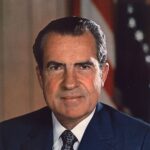 also capped off a somewhat embarrassing period for the USA. The United States was not supportive of Allende’s regime either, and “under the orders of Richard Nixon, the CIA (as its own website attests) had spent the previous three years helping plot coups in Chile and trying to otherwise destabilize Allende’s government. Another foreign policy success!” Ironically, the democratically elected Allende was succeeded by the brutal dictator General Augusto Pinochet, who ruled over Chile with an iron fist for the next 17 years.
also capped off a somewhat embarrassing period for the USA. The United States was not supportive of Allende’s regime either, and “under the orders of Richard Nixon, the CIA (as its own website attests) had spent the previous three years helping plot coups in Chile and trying to otherwise destabilize Allende’s government. Another foreign policy success!” Ironically, the democratically elected Allende was succeeded by the brutal dictator General Augusto Pinochet, who ruled over Chile with an iron fist for the next 17 years.
While Allende was democratically elected, he was also a Marxist leader and so not really what the United States wanted to see for Chile. When the coup began, Allende retreated with his supporters to La Moneda. The Presidential palace was a fortress-like structure. Pinochet’s army surrounded the palace with tanks and infantry and ordered air force jets to bomb it. Allende survived the aerial attack but then apparently shot himself to death as troops stormed the burning palace, reportedly using an automatic rifle given to him as a gift by Cuban dictator Fidel Castro.
Allende was born into an upper-middle-class Chilean family in 1908. By 1933, he was a Marxist activist and worked as a doctor and was a founding member of Chile’s Socialist Party. He was elected to the Chamber of Deputies in 1937 and later served as minister of health in the leftist government of President Pedro Aguirre Cerda. His political career continued to grow, and in 1945, he became a senator. Then, he suffered a bit of a setback when he ran for president several times in the 1950s and 1960s but lost. Then in September 1970 he won a three-sided presidential race with 36.3 percent of the vote, but without a clear majority, his election had to be confirmed by the Chilean Congress. Once confirmed, Allende became president.
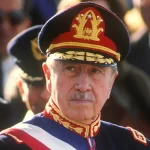
After Allende was declared the victor, President Richard Nixon summoned CIA Director Richard Helms to the White House and ordered him in no uncertain terms to prevent Allende from coming to power or to unseat him. Nixon knew that Allende had threatened to nationalize US owned industries in Chile. Nixon did not want another Fidel Castro coming to power in an American hemisphere during his watch. It was a serious concern, so President Nixon authorized $10 million for the covert operation against Allende and instructed that it be carried out without the knowledge of the US embassy in Chile. In the end, the “problem” was solved by the coup that took place. Of course, the solution was just as bad, if not worse than the original problem.

 When I look back on the events of September 11, 2001, I find it really hard to believe that it has been 23 years already. So many lives lost…moms and dads, brothers and sisters, sons and daughters. The children born right after losing a parent to the 911 Attacks are grown now. Some may have begun their own families. All of the children who lost loved ones are adults, for whom the ramifications of those attacks are very real. They lost a parent, and some never got to know their parent. Of course, for anyone who lost someone in the attacks, the ramifications are very real. You don’t ever lose a loved one without feeling the immense pain of that loss, and when that loss comes from a brutal and unwarranted attack it especially hard to wrap your head around it. Why?? That is the ultimate question, and in this case the one that was never really answered, except to say that a deranged monster had an “imagined score” to settle.
When I look back on the events of September 11, 2001, I find it really hard to believe that it has been 23 years already. So many lives lost…moms and dads, brothers and sisters, sons and daughters. The children born right after losing a parent to the 911 Attacks are grown now. Some may have begun their own families. All of the children who lost loved ones are adults, for whom the ramifications of those attacks are very real. They lost a parent, and some never got to know their parent. Of course, for anyone who lost someone in the attacks, the ramifications are very real. You don’t ever lose a loved one without feeling the immense pain of that loss, and when that loss comes from a brutal and unwarranted attack it especially hard to wrap your head around it. Why?? That is the ultimate question, and in this case the one that was never really answered, except to say that a deranged monster had an “imagined score” to settle.
A total of 2,977 people were killed in New York City, Washington, DC and outside of Shanksville, Pennsylvania on September 11, 2001. Of those, 2,753 were killed at the World Trade Center site in Lower Manhattan. These consisted of victims from hijacked American Airlines Flight 11 and United Airlines Flight 175 both of which were  intentionally crashed into the North and South Towers, or as a result of the crashes. Of those who perished during the initial attacks and the subsequent collapses of the Towers, 343 were New York City firefighters, 23 were New York City police officers and 37 were officers at the Port Authority. The victims ranged in age from two to 85 years. Approximately 75-80% of the victims were men. A total of 184 people were killed at the Pentagon in Washington, when hijacked American Airlines Flight 77 crashed into the building. Near Shanksville, Pennsylvania, 40 passengers and crew members aboard United Airlines Flight 93 died when the plane crashed into a field. It is believed that the hijackers crashed the plane in that location, rather than their unknown target, after the passengers and crew attempted to retake control of the flight deck. As of January 18, 2024, 1,650 of 2,753 WTC victims’ remains have been positively identified, according to the medical examiner’s office…which means that the families of 1,103 people have not been able to have closure. Unfortunately, the fact remains that many will never be identified.
intentionally crashed into the North and South Towers, or as a result of the crashes. Of those who perished during the initial attacks and the subsequent collapses of the Towers, 343 were New York City firefighters, 23 were New York City police officers and 37 were officers at the Port Authority. The victims ranged in age from two to 85 years. Approximately 75-80% of the victims were men. A total of 184 people were killed at the Pentagon in Washington, when hijacked American Airlines Flight 77 crashed into the building. Near Shanksville, Pennsylvania, 40 passengers and crew members aboard United Airlines Flight 93 died when the plane crashed into a field. It is believed that the hijackers crashed the plane in that location, rather than their unknown target, after the passengers and crew attempted to retake control of the flight deck. As of January 18, 2024, 1,650 of 2,753 WTC victims’ remains have been positively identified, according to the medical examiner’s office…which means that the families of 1,103 people have not been able to have closure. Unfortunately, the fact remains that many will never be identified.
One can only hope and pray that these family can find peace. Their loved ones did nothing wrong. They were 
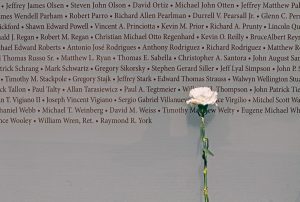 simply going about their normal day. They had no idea when they woke up that morning, that by the end of the day, their lives would be over, and their families would be thrown into extreme grieving. We must also hope that those of us who are left behind can somehow find a way to be kinder to each other. It is the only way to heal some of the pain people go through in their everyday lives. Today, we remember those we lost on September 11, 2001, and those left behind to carry on.
simply going about their normal day. They had no idea when they woke up that morning, that by the end of the day, their lives would be over, and their families would be thrown into extreme grieving. We must also hope that those of us who are left behind can somehow find a way to be kinder to each other. It is the only way to heal some of the pain people go through in their everyday lives. Today, we remember those we lost on September 11, 2001, and those left behind to carry on.
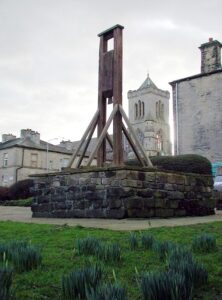
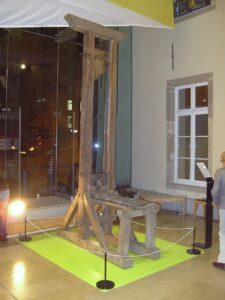 Death by guillotine…just the thought makes us cringe. Nevertheless, this form of the death sentence has been widely used throughout history, though not anymore. The last person to be executed by guillotine was Hamida Djandoubi, a Tunisian immigrant convicted of murder. He was executed at Baumetes Prison in Marseille, France. A guillotine is “an apparatus designed for efficiently carrying out executions by beheading. The device consists of a tall, upright frame with a weighted and angled blade suspended at the top. The condemned person is secured with a pillory at the bottom of the frame, holding the position of the neck directly below the blade. The blade is then released, swiftly and forcefully decapitating the victim with a single, clean pass; the head falls into a basket or other receptacle below.” While it might be a quick, clean, and efficient form of execution, it is one that brings thoughts of horror to most people.
Death by guillotine…just the thought makes us cringe. Nevertheless, this form of the death sentence has been widely used throughout history, though not anymore. The last person to be executed by guillotine was Hamida Djandoubi, a Tunisian immigrant convicted of murder. He was executed at Baumetes Prison in Marseille, France. A guillotine is “an apparatus designed for efficiently carrying out executions by beheading. The device consists of a tall, upright frame with a weighted and angled blade suspended at the top. The condemned person is secured with a pillory at the bottom of the frame, holding the position of the neck directly below the blade. The blade is then released, swiftly and forcefully decapitating the victim with a single, clean pass; the head falls into a basket or other receptacle below.” While it might be a quick, clean, and efficient form of execution, it is one that brings thoughts of horror to most people.
The guillotine first gained fame, when physician and revolutionary Joseph-Ignace Guillotin won passage of a law 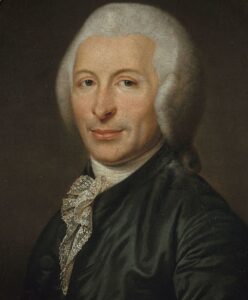 requiring all death sentences to be carried out by “means of a machine” during the French Revolution. This was not the first use of decapitating machines, however. They had been used earlier in Ireland and England. Guillotin and his supporters viewed these devices as more humane than other execution techniques, such as hanging or firing squad. I suppose I can see that, because both hangings and firing squad executions have gone wrong, and the guilty party suffered a prolonged period of agony before finally succumbing to their fate. To bring about a death that was more instantaneous, although not without agony…considering the moments before the blade dropped, the guillotine was brought into the mainstream of executions. A French decapitating machine was built and tested on cadavers. On April 25, 1792, a highwayman became the first person in Revolutionary France to be executed by this method.
requiring all death sentences to be carried out by “means of a machine” during the French Revolution. This was not the first use of decapitating machines, however. They had been used earlier in Ireland and England. Guillotin and his supporters viewed these devices as more humane than other execution techniques, such as hanging or firing squad. I suppose I can see that, because both hangings and firing squad executions have gone wrong, and the guilty party suffered a prolonged period of agony before finally succumbing to their fate. To bring about a death that was more instantaneous, although not without agony…considering the moments before the blade dropped, the guillotine was brought into the mainstream of executions. A French decapitating machine was built and tested on cadavers. On April 25, 1792, a highwayman became the first person in Revolutionary France to be executed by this method.
Though it was not originally named a “guillotine,” the device soon became known as such after its advocate, Joseph-Ignace Guillotin. Through the use of the device, more than 10,000 people lost their heads during the 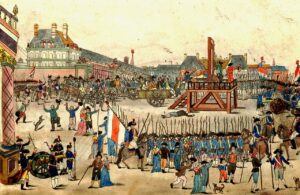
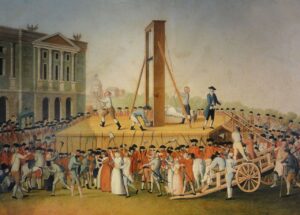 Revolution, including Louis XVI and Marie Antoinette, the former king and queen of France. France continued to us the guillotine during the 19th and 20th centuries, and incredibly, the last execution by guillotine occurred in 1977. Then, France outlawed capital punishment altogether in September 1981, and so the guillotine was abandoned forever. There is a museum dedicated to the guillotine in Liden, Sweden.
Revolution, including Louis XVI and Marie Antoinette, the former king and queen of France. France continued to us the guillotine during the 19th and 20th centuries, and incredibly, the last execution by guillotine occurred in 1977. Then, France outlawed capital punishment altogether in September 1981, and so the guillotine was abandoned forever. There is a museum dedicated to the guillotine in Liden, Sweden.

 My youngest grandson, Josh Petersen ended his 25th year of life by packing up his wife, Athena Petersen and their sons, Justin and Axel, and moving them to Lawton, Oklahoma. The day they left town was such a sad day for those of us left behind, and while it was also sad for them, they went with a sense of adventure too. I can’t blame them for feeling the excitement of the move, but of course, I am one of those left behind. For us, their parents, grandparents, siblings, niece and nephews, there is an empty space that now lives in our lives. Nevertheless, we will find creative ways to stay close to these loved ones too.
My youngest grandson, Josh Petersen ended his 25th year of life by packing up his wife, Athena Petersen and their sons, Justin and Axel, and moving them to Lawton, Oklahoma. The day they left town was such a sad day for those of us left behind, and while it was also sad for them, they went with a sense of adventure too. I can’t blame them for feeling the excitement of the move, but of course, I am one of those left behind. For us, their parents, grandparents, siblings, niece and nephews, there is an empty space that now lives in our lives. Nevertheless, we will find creative ways to stay close to these loved ones too.
Josh will begin his 26th year with a new job. He is still doing the same work he was in Casper…recharging fire 
 extinguishers, but now he will be working at Fire Pros, LLC in Lawton. This was a step up for him, as he is making five dollars more an hour than he was here in Casper. Josh has to improve himself, especially when he and Athina are expecting their third son at the end of January. He rather fell into this work and was trained well at All Out Fire in Casper, and his new employer saw the great value in having a pre-trained employee on staff. He jumped at the chance to hire Josh. Josh had wanted to be a firefighter when he went to college, but his knees would not allow him to do so. This is for him, the next best option. It may not always be what he wants to do, but I know that whatever he decides to do, he will excel at, because Josh is a hardworking man, who is very loyal to his employers. He always has been, and we are very proud of his work ethic.
extinguishers, but now he will be working at Fire Pros, LLC in Lawton. This was a step up for him, as he is making five dollars more an hour than he was here in Casper. Josh has to improve himself, especially when he and Athina are expecting their third son at the end of January. He rather fell into this work and was trained well at All Out Fire in Casper, and his new employer saw the great value in having a pre-trained employee on staff. He jumped at the chance to hire Josh. Josh had wanted to be a firefighter when he went to college, but his knees would not allow him to do so. This is for him, the next best option. It may not always be what he wants to do, but I know that whatever he decides to do, he will excel at, because Josh is a hardworking man, who is very loyal to his employers. He always has been, and we are very proud of his work ethic.
Josh is also a loyal family man and is always willing to sacrifice his needs to make sure his wife and sons have everything they need. Josh met Athena when they were in middle school, and as often happens, they didn’t 
 know that this was their forever love, until much later when they ended up working together. I think they knew the minute they found out they were working together, however. The rest is history, as they say. In short order they were married, had two sons, and have one on the way. They love taking the boys to the park, and other places of interest…and they take lots of pictures, which we will all treasure even more now. We want them to be happy, and their lives to be full, but as long as they live away from us, we will all miss them very much. Nevertheless, as they have said before, “Home is Wherever I’m With You” and so it is. Today is Josh’s 26th birthday. Happy birthday Josh!! Have a great day!! We love you!!
know that this was their forever love, until much later when they ended up working together. I think they knew the minute they found out they were working together, however. The rest is history, as they say. In short order they were married, had two sons, and have one on the way. They love taking the boys to the park, and other places of interest…and they take lots of pictures, which we will all treasure even more now. We want them to be happy, and their lives to be full, but as long as they live away from us, we will all miss them very much. Nevertheless, as they have said before, “Home is Wherever I’m With You” and so it is. Today is Josh’s 26th birthday. Happy birthday Josh!! Have a great day!! We love you!!

 Many factors go into the “make or break” status of a town. Sometimes, it’s all about location. Other times, it’s about what is built after the town is formed. Still other times, it’s about what is discovered there and how low its supply lasts. The town of Doaksville, Oklahoma was once the largest town in the Choctaw Nation. Doaksville was founded in the early 1820s when Josiah S Doaks and his brother established a trading post. It was a humble beginning that sprang from the anticipation of the arrival of the Choctaw Indians to the area after the signing of the Treaty of Doak’s Stand in October 1820. The brothers moved westward with their boats filled with goods for the trading post and headed up the Mississippi and Red Rivers. Soon, other settlers moved into the area to be close to the store for mutual protection.
Many factors go into the “make or break” status of a town. Sometimes, it’s all about location. Other times, it’s about what is built after the town is formed. Still other times, it’s about what is discovered there and how low its supply lasts. The town of Doaksville, Oklahoma was once the largest town in the Choctaw Nation. Doaksville was founded in the early 1820s when Josiah S Doaks and his brother established a trading post. It was a humble beginning that sprang from the anticipation of the arrival of the Choctaw Indians to the area after the signing of the Treaty of Doak’s Stand in October 1820. The brothers moved westward with their boats filled with goods for the trading post and headed up the Mississippi and Red Rivers. Soon, other settlers moved into the area to be close to the store for mutual protection.
There were raids from the Plains Indians, especially those from Texas, which necessitated the establishment in 1824, of nearby Fort Towson. With the establishment of the fort, Doaksville began to grow and had all the makings of becoming a permanent town. Roads were built, between Doaksville, the trading post, and Fort Towson to establish a supply line. Doaksville sat at the center of these crossroads, and Doaksville began to prosper from the Central National Road of Texas that ran from Dallas to the Red River before connecting with the Fort Towson Road, which went on to Fort Gibson and beyond to Fort Smith, Arkansas. Doaksville seemed to be right in the thick of things. In addition, steamboats on the Red River connected with New Orleans at a public landing just a few miles south of Doaksville, carrying supplies to Fort Towson and agriculture products out of the region. It looked like Doaksville was headed for greatness.
Then, in 1837, the Choctaw and the Chickasaw signed the Treaty of Doaksville, which allowed the Chickasaw to lease the westernmost portion of the Choctaw Nation for settlement. By 1840, Doaksville was really growing. It now sported five large merchandise stores, two of which were owned by Choctaw Indians and the others by licensed white traders. There was a harness and saddle shop, wagon yard, blacksmith shop, gristmill, hotel, council house, and church. A newspaper called the Choctaw Intelligencer…printed in both English and Choctaw.
Of course, with the settlement came the missionaries. A missionary named Alvin Goode described the settlement at the time, “The trading establishment of Josiah Doak and Vinson Brown Timms, an Irishman, had the contract to supply the Indians their rations, figured at 13 cents a ration. A motley crowd always assembled 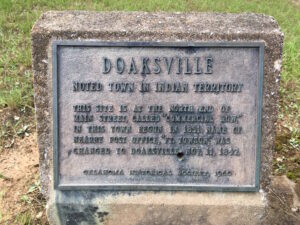 at Doaksville on annuity days to receive them. Some thousands of Indians were scattered over a nearly square mile tract around the pay house. There were cabins, tents, booths, stores, shanties, wagons, carts, campfires; white, red, black and mixed in every imaginable shade and proportion and dressed in every conceivable variety of style, from tasty American clothes to the wild costumes of the Indians; buying, selling, swapping, betting, shooting, strutting, talking, laughing, fiddling, eating, drinking, smoking, sleeping, seeing and being seen, all bundled together.”
at Doaksville on annuity days to receive them. Some thousands of Indians were scattered over a nearly square mile tract around the pay house. There were cabins, tents, booths, stores, shanties, wagons, carts, campfires; white, red, black and mixed in every imaginable shade and proportion and dressed in every conceivable variety of style, from tasty American clothes to the wild costumes of the Indians; buying, selling, swapping, betting, shooting, strutting, talking, laughing, fiddling, eating, drinking, smoking, sleeping, seeing and being seen, all bundled together.”
The town of Doaksville continued to grow, and in 1847 a post office was established. By 1850, the town had grown to more than thirty buildings, including stores, a jail, a school, a hotel, and two newspapers. Now established, it became the capital of the Choctaw Nation. For the next several years, Doaksville continued to thrive. Then, in 1854 Fort Towson was abandoned, and that spelled disaster for Doaksville. Without the business from the soldiers at the fort, Doaksville began to decline. Nevertheless, it would remain the tribal capital for the next nine years.
The Civil War, which broke out in 1861, spelled disaster for Doaksville. The region’s plantation-based economy was hit especially hard. In 1863, the Choctaw capital was moved to Chahta Tamaha, where it would remain until 1882, when it was moved for a third and final time to Tuskahoma, Oklahoma. The largest force in the Indian Territory was commanded by Confederate Brigadier General Stand Watie, chief of the Cherokee Nation. He was not one to admit defeat, and he would become the last Confederate general to surrender his command. When the leaders of the Confederate Indians learned that the government in Richmond, Virginia, had fallen and the Eastern armies had surrendered, most began making plans for surrender. The chiefs convened the Grand Council on June 15, 1865, and passed resolutions calling for Indian commanders to lay down their arms. Brigadier General Stand Watie refused until June 23, 1865, 75 days after Lee’s surrender in the East. At that point, he finally accepted the futility of continued resistance. He surrendered his battalion of Creek, Seminole, Cherokee, and Osage Indians to Lieutenant Colonel Asa C Matthews at Doaksville.
The collapse of the southern economy based on slave labor basically signed the death warrant Doaksville, and with the construction of the Saint Louis and San Francisco Railroad through the Southern Choctaw Nation in 1900-1901, its fate was sealed. At that time, the few buildings that remained at Doaksville were abandoned or moved to a new town that formed near the railroad, taking the name of the old post…Fort Towson. In 1903, the name of the Doaksville post office was changed to Fort Towson.
In 1960, the old town of Doaksville was acquired by the Oklahoma Historical Society. Little remained on the surface to betray its former importance, but in the 1990s, several archaeological excavations occurred, exposing the foundations of several buildings, including a jail, wells, a store, a hotel, and thousands of artifacts. 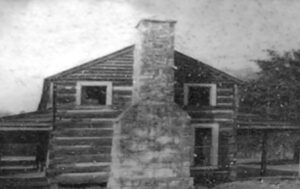
 Today, a walking trail leads visitors through the site with interpretive signs telling the history of the old settlement. The old townsite has been designated as a National Historic Site, can be accessed through the Fort Towson Cemetery. A portion of the cemetery holds the burial sites of many important people who lived and died in Doaksville.
Today, a walking trail leads visitors through the site with interpretive signs telling the history of the old settlement. The old townsite has been designated as a National Historic Site, can be accessed through the Fort Towson Cemetery. A portion of the cemetery holds the burial sites of many important people who lived and died in Doaksville.
 On August 21, 1911, the Mona Lisa was stolen from the Louvre Museum in Paris, in what seemed like an impossible scenario. The theft of the Mona Lisa was called “art heist of the century,” but it was actually pretty basic. A small, mustached man entered the Louvre Museum in Paris, on the evening of Sunday, August 20, 1911, and made his way to the Salon Carré, where the Da Vinci painting was housed alongside several other masterworks. Maybe the museum didn’t think a theft could happen to them, it’s hard to say, but security in the museum was lax, so the man found it easy to stow away inside a storage closet. He remained hidden there until the following morning when the Louvre was closed, and there were few people around. He saw his chance to escape at around 7:15 am. He put on one of the white aprons worn by the museum’s employees. Then after checking to see if the coast was clear, he walked up to the Mona Lisa, took if off of the wall and carried it to a nearby service stairwell. There he removed it from the frame and tried to exit the stairwell into a courtyard. The door was locked, so he placed the Mona Lisa, which he had wrapped in a white sheet, on the floor and tried to take apart the doorknob. That got him nowhere, but an unsuspecting Louvre employee
On August 21, 1911, the Mona Lisa was stolen from the Louvre Museum in Paris, in what seemed like an impossible scenario. The theft of the Mona Lisa was called “art heist of the century,” but it was actually pretty basic. A small, mustached man entered the Louvre Museum in Paris, on the evening of Sunday, August 20, 1911, and made his way to the Salon Carré, where the Da Vinci painting was housed alongside several other masterworks. Maybe the museum didn’t think a theft could happen to them, it’s hard to say, but security in the museum was lax, so the man found it easy to stow away inside a storage closet. He remained hidden there until the following morning when the Louvre was closed, and there were few people around. He saw his chance to escape at around 7:15 am. He put on one of the white aprons worn by the museum’s employees. Then after checking to see if the coast was clear, he walked up to the Mona Lisa, took if off of the wall and carried it to a nearby service stairwell. There he removed it from the frame and tried to exit the stairwell into a courtyard. The door was locked, so he placed the Mona Lisa, which he had wrapped in a white sheet, on the floor and tried to take apart the doorknob. That got him nowhere, but an unsuspecting Louvre employee 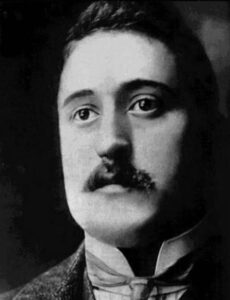 thought he was one of the Louvre’s plumbers, opened the door and let him out. He thanked the man and walked away.
thought he was one of the Louvre’s plumbers, opened the door and let him out. He thanked the man and walked away.
Then on September 7, 1911, came a shocking arrest. French poet Guillaume Apollinaire was jailed on suspicion of stealing Leonardo da Vinci’s Mona Lisa from the Louvre Museum in Paris. Apollinaire was a 31-year-old poet, who was known for his radical views and support for “extreme avant-garde” art movements, but his origins were shrouded in mystery. These days, it is believed that he was born in Rome and raised in Italy. At age 20, He moved to Paris and quickly blended in with the city’s bohemian crowd. His first volume of poetry, The Rotting Magician, appeared in 1909, followed by a story collection in 1910. Apollinaire was a supporter of Cubism, he published a book about the subject, Cubist Painters, in 1913. Cubism is “a revolutionary style of visual art invented by Pablo Picasso and Georges Braque in the early 20th century1. It is an influential modernist art movement that emerged in Paris, characterized by the transformation of objects and subjects 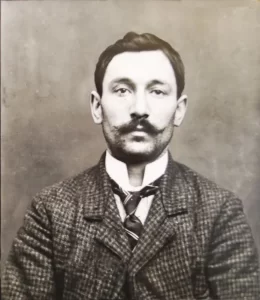 into geometric shapes, often resembling cubes or facets.” The same year, he published his most esteemed work, Alcools, where he used a variety of poetic forms and traditions to capture everyday street speech. His experimental play The Breasts of Tiresias was produced in 1917, for which he coined the term “surrealist.”
into geometric shapes, often resembling cubes or facets.” The same year, he published his most esteemed work, Alcools, where he used a variety of poetic forms and traditions to capture everyday street speech. His experimental play The Breasts of Tiresias was produced in 1917, for which he coined the term “surrealist.”
His poetic works were inspirational, but Apollinaire’s mysterious background and radical views led authorities to view him as a dangerous foreigner and therefore a prime suspect in the Mona Lisa heist. Still with all their searching, they could find no evidence that linked Apollinaire to the theft. Apollinaire was released after five days. It seemed that the Mona Lisa, which is today valued at about 1 billion dollars, was lost forever. Then two years later, a former employee of the Louvre, Vincenzo Peruggia, was arrested while trying to sell the famous painting to an art dealer. He had been the bold thief and Apollinaire had simply been wrongfully accused.
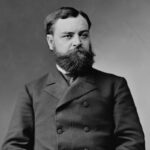
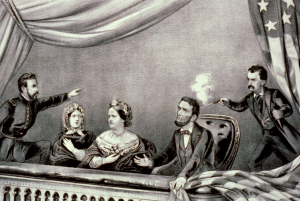 Whether Robert Lincoln’s presence at or near a presidential assassination had anything to do with bringing it to pass or not, is irrelevant…he began to think his presence was relevant. Robert Todd Lincoln was Abraham Lincoln’s son, and while he wasn’t present at his father’s assassination, he was close. He was at the White House, and upon hearing of the assassination, he rushed to be with his parents. The president was moved to the Petersen House after the shooting, where Robert attended his father’s deathbed…and so began a series of strange coincidences in which Robert Todd Lincoln was either present or nearby when three presidential assassinations occurred. It isn’t surprising that Robert Lincoln began to think that maybe he was a “jinx” or “bad luck” if he was at a presidential event, but of course that was not the case. It was just what he believed.
Whether Robert Lincoln’s presence at or near a presidential assassination had anything to do with bringing it to pass or not, is irrelevant…he began to think his presence was relevant. Robert Todd Lincoln was Abraham Lincoln’s son, and while he wasn’t present at his father’s assassination, he was close. He was at the White House, and upon hearing of the assassination, he rushed to be with his parents. The president was moved to the Petersen House after the shooting, where Robert attended his father’s deathbed…and so began a series of strange coincidences in which Robert Todd Lincoln was either present or nearby when three presidential assassinations occurred. It isn’t surprising that Robert Lincoln began to think that maybe he was a “jinx” or “bad luck” if he was at a presidential event, but of course that was not the case. It was just what he believed.
Robert was at the Sixth Street Train Station in Washington DC, at President James A Garfield’s invitation, when the President Garfield was shot by Charles J Guiteau on July 2, 1881. In fact, Robert was an eyewitness to the event. He was actually serving as Garfield’s Secretary of War at the time. President Garfield, the 20th president of the United States, was shot at the Baltimore and Potomac Railroad Station in Washington DC at 9:30 am on Saturday, July 2, 1881. He actually lived two and a half months before passing away in Elberon, New Jersey, on September 19, 1881.
Then, on September 6, 1901, at President William McKinley’s invitation, Robert Lincoln was at the Pan-American Exposition in Buffalo, New York. For Robert, it happened again. The president was shot by Leon Czolgosz and though Robert was not an eyewitness to the event, he was just outside the building where the shooting occurred. Robert Lincoln saw these coincidences, and it really began to bother him, even though there was 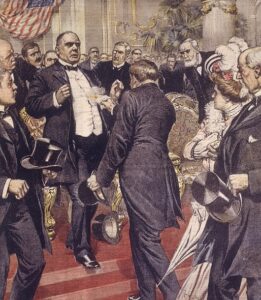
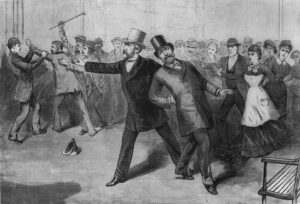 really no rational connection. The concern for Robert Lincoln was so great that he is said to have refused a later presidential invitation with the comment, “No, I’m not going, and they’d better not ask me, because there is a certain fatality about presidential functions when I am present.” While I don’t think his presence had anything to do with the assassinations, I think that Robert Lincoln suffered great distress from the things he witnessed or almost witnessed. That really must have been an absolutely horrible feeling for him.
really no rational connection. The concern for Robert Lincoln was so great that he is said to have refused a later presidential invitation with the comment, “No, I’m not going, and they’d better not ask me, because there is a certain fatality about presidential functions when I am present.” While I don’t think his presence had anything to do with the assassinations, I think that Robert Lincoln suffered great distress from the things he witnessed or almost witnessed. That really must have been an absolutely horrible feeling for him.

 Our aunt, Pearl Hein has spent much of her life taking care of others. She took care of her parents, husband, children, and grandchildren. She was also worked full time…plus. It seemed that the IGA in Forsyth, Montana where she lives, couldn’t function if Pearl wasn’t there. Eventually though, came the time for her to retire. I’m sure that IGA was sorry to see her go, but she was ready. After that, she took care of her husband, Uncle Eddie Hein until his passing in 2019. A short time later, in early 2020, her son, Larry Hein also passed away. This left Pearl feeling alone, even though, she has a daughter, Kim Arani living in Texas. For the most part, the loneliness was short lived. Where Pearl hadn’t really traveled much, she now made some trips to visit Kim, and I think she has really enjoyed that, and that makes me very happy. They looked like they had a great time.
Our aunt, Pearl Hein has spent much of her life taking care of others. She took care of her parents, husband, children, and grandchildren. She was also worked full time…plus. It seemed that the IGA in Forsyth, Montana where she lives, couldn’t function if Pearl wasn’t there. Eventually though, came the time for her to retire. I’m sure that IGA was sorry to see her go, but she was ready. After that, she took care of her husband, Uncle Eddie Hein until his passing in 2019. A short time later, in early 2020, her son, Larry Hein also passed away. This left Pearl feeling alone, even though, she has a daughter, Kim Arani living in Texas. For the most part, the loneliness was short lived. Where Pearl hadn’t really traveled much, she now made some trips to visit Kim, and I think she has really enjoyed that, and that makes me very happy. They looked like they had a great time.
Pearl is a kind and caring woman, and she is loved by many. Her humble nature tends to make her think less of 
 her own value though. I know that my family and my in-laws always loved Pearl and enjoyed spending time at her home. I only wish that she could have come to Casper more, but she always worked too hard, and didn’t often give herself the time off that she deserved. That always made me sad, because she really did deserve that time off. Pearl and Eddie always had a garden and she canned food from the garden to serve her family. Pearl was a great cook…I mean a really great cook. You never went away from her table hungry, and more likely you were too full, because you just couldn’t stop eating.
her own value though. I know that my family and my in-laws always loved Pearl and enjoyed spending time at her home. I only wish that she could have come to Casper more, but she always worked too hard, and didn’t often give herself the time off that she deserved. That always made me sad, because she really did deserve that time off. Pearl and Eddie always had a garden and she canned food from the garden to serve her family. Pearl was a great cook…I mean a really great cook. You never went away from her table hungry, and more likely you were too full, because you just couldn’t stop eating.
Pearl still lives in Forsyth, Montana, as do some of her grandchildren, and her siblings live nearby as well. I’m sure that is part of what keeps Pearl from moving to Texas to be nearer her daughter…that and maybe the
 Texas heat. I’m not sure, but some people like that heat and others really don’t. Still, she cand go visit in the cold winter months and at least enjoy not being in the “frozen tundra” of Montana. Ok maybe it really isn’t the frozen tundra, but it often feels that way in the coldest parts of Winter. It is my firm belief, that Pearl deserves whatever she wants to make her happy. She has spent so much of her life making others happy, healthy, and blessed. Now it is time for her to do things that make her happy. Today is Pearl’s 75th birthday. Happy birthday Pearl!! Have a great day!! We love you!!
Texas heat. I’m not sure, but some people like that heat and others really don’t. Still, she cand go visit in the cold winter months and at least enjoy not being in the “frozen tundra” of Montana. Ok maybe it really isn’t the frozen tundra, but it often feels that way in the coldest parts of Winter. It is my firm belief, that Pearl deserves whatever she wants to make her happy. She has spent so much of her life making others happy, healthy, and blessed. Now it is time for her to do things that make her happy. Today is Pearl’s 75th birthday. Happy birthday Pearl!! Have a great day!! We love you!!

